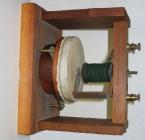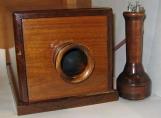15
The next step was to construct a better transmitter based on the human ear physiology. His Gallows Frame transmitter used a diaphragm stretched over a hollow circular base, the diaphragm in turn was fixed to a metal reed that was free to vibrate, it in turn produced a weak current in the coil which was connected to the receiver. Speech was heard on the receiver although indistinctly. At this stage at the suggestion of his financial backers he filed a patent even though he didn't have a working model. It was quite fortuitous because his patent application only preceded Elisha Gray's caveat (an intention to file a patent) by a few hours.17
Bell came up with the liquid transmitter next and with it he was able to reproduce speech faithfully. The diaphragm is attached to a wire that is barely touching a lightly acidic liquid in a metal container. A wire connects one terminal of a battery to the wire attached to the diaphragm, another wire connects the metal container with the acid to a distant harmonic telegraph receiver. The other lead from the receiver is connected to other battery terminal. This set up was the one recognized as the first to transmit intelligible speech by telephonic telegraph as it was originally called.20
He then proceeded to develop his first commercial telephone which was based on his patent application. This new phone was successful, it used the same device to transmit and receive. However, because Bell's transmitter only produced a weak signal, it required the user to shout into the instrument.22
Initially phones were connected to each other in pairs, soon it became obvious there was a need to connect any one phone with any other. The first switchboard was installed in New Haven, Connecticut, USA. It was similar to the one pictured which was the first Canadian installation in 1878, in Hamilton, Ontario.To use these early instruments was a little awkward, one had to first push a button a specific number of times matching your phone number on the instrument to signal the operator, then keeping it depressed during the entire duration of the call. The early switchboard gave way rapidly to more compact boards since they could only accommodate about seven lines. The bells on the switchboard were replaced by signal devices that drop a little door when activated.
The first operators were young men, frequently boys, however, they proved unreliable because they were unruly, impolite with customers and frequently damaged the equipment by whittling it. It took a few years before young women were selected for their more gentle manner. They were courteous, reliable and as a bonus their voices were better heard than a man's because they are higher pitched.





